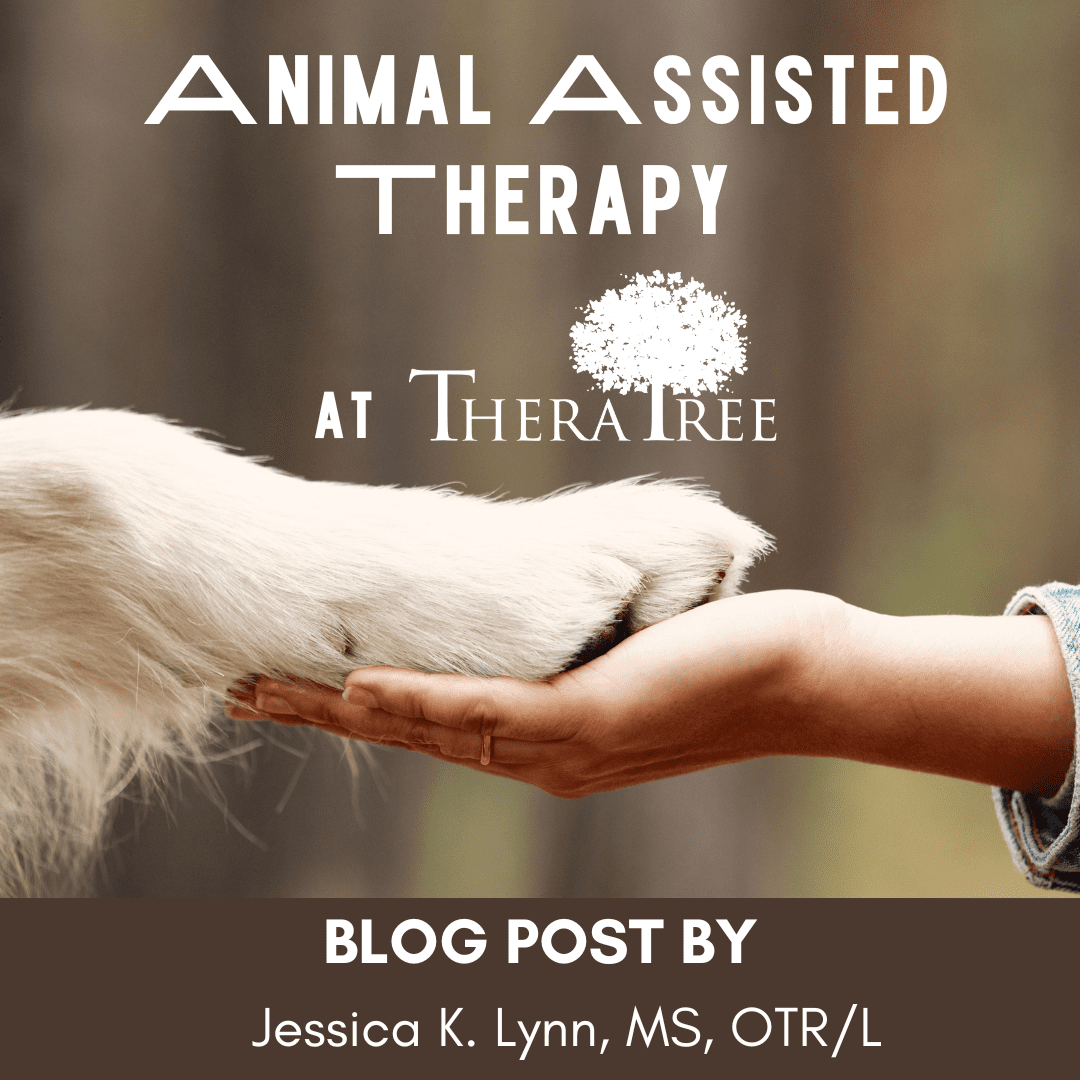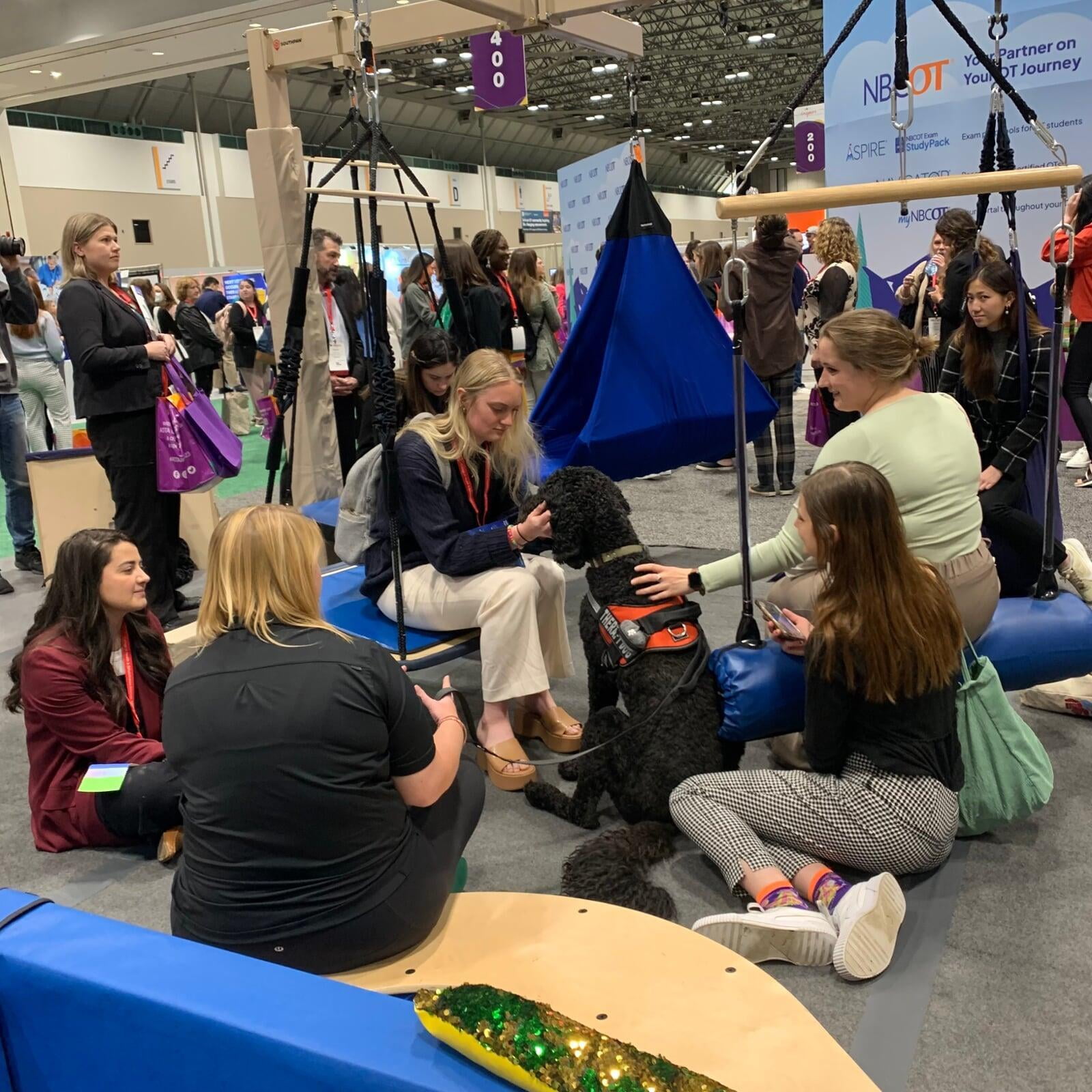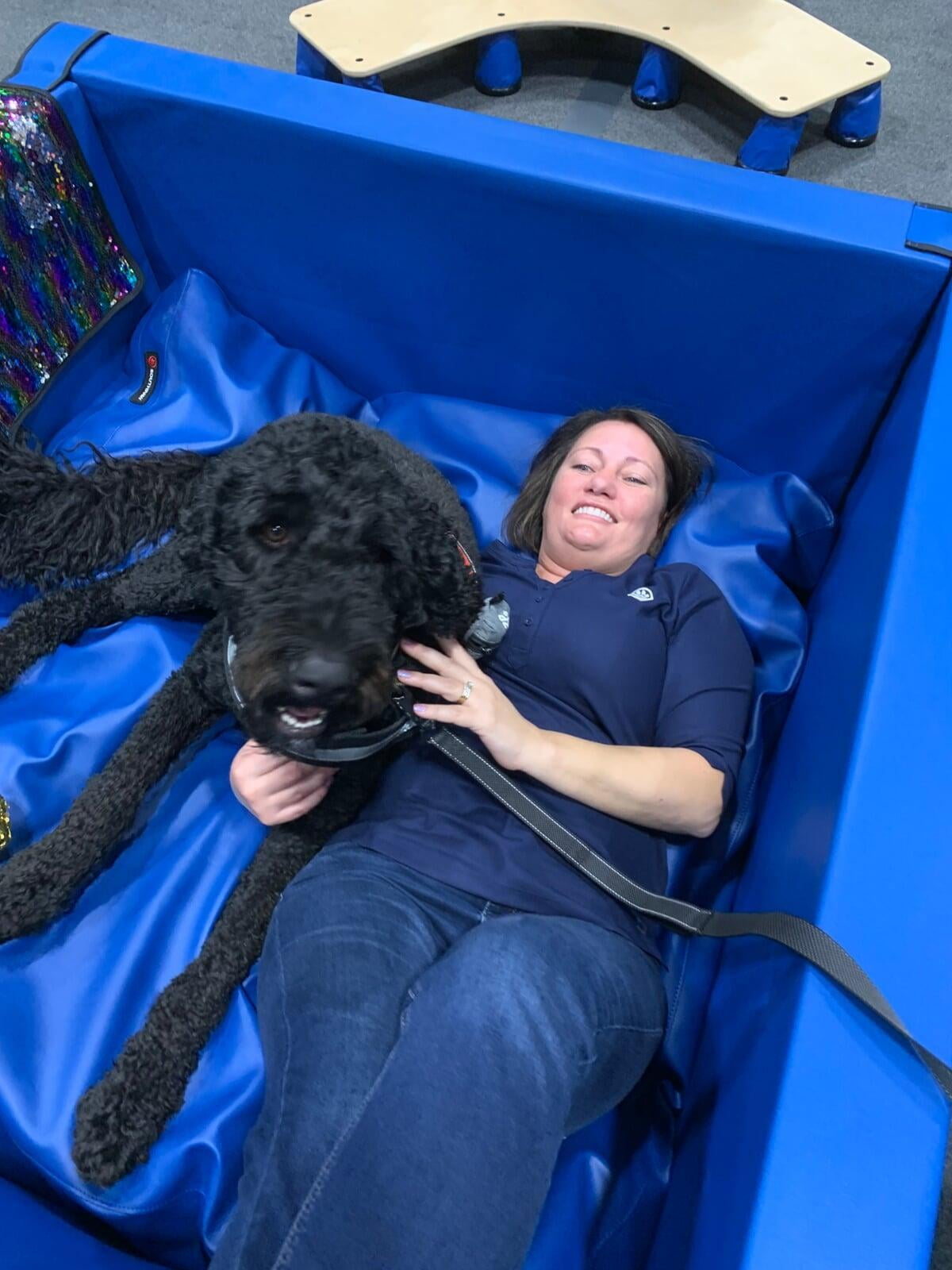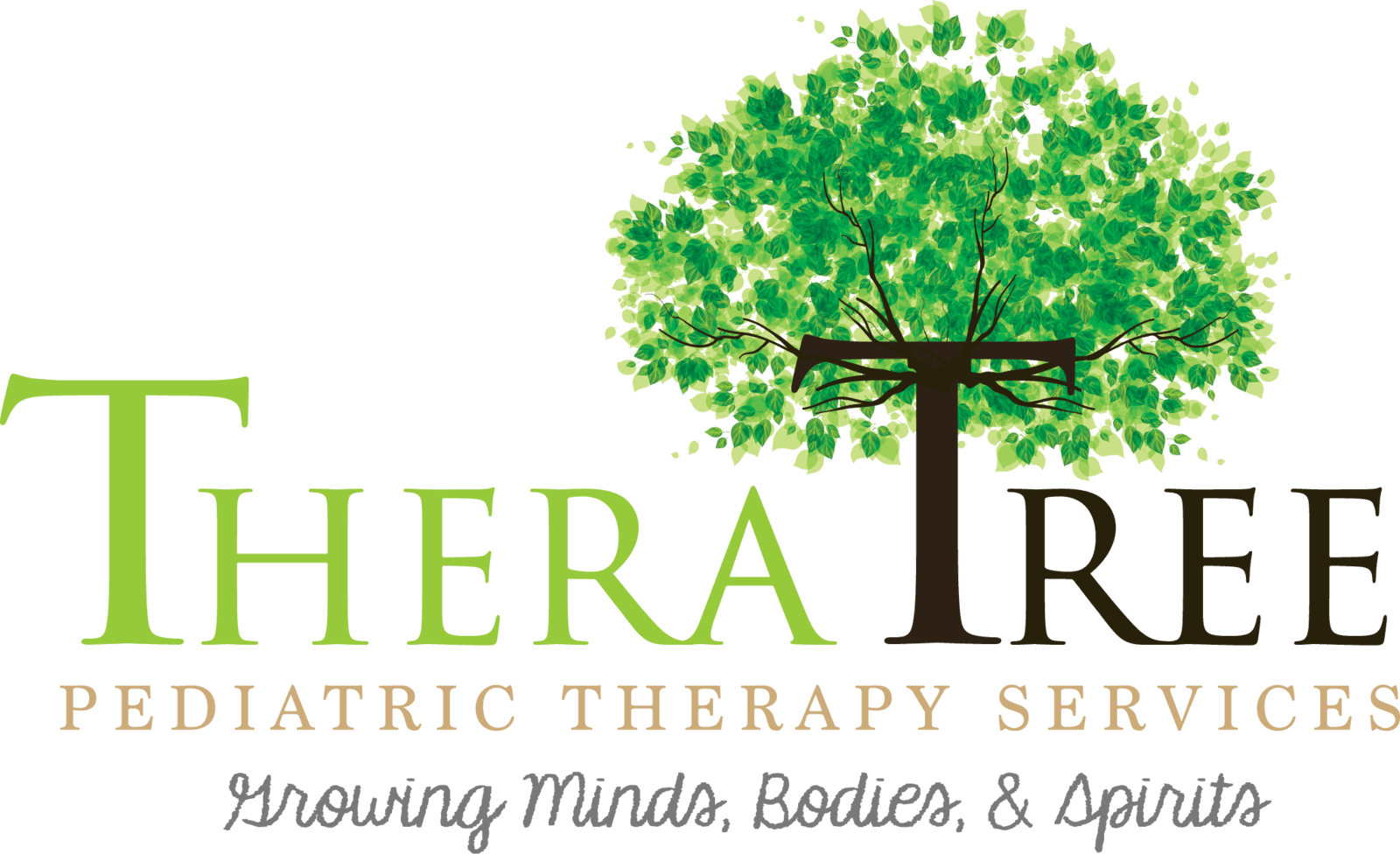
Animal Assisted Therapy
Our Animal Assisted Therapy program has begun with Bo the Certified Therapy Dog!
Animal Assisted Intervention (AAI): An alternative or complementary type of therapy intervention that includes the use of animals as a means to deliver therapeutic intervention in a treatment. Animal-assisted interventions are goal-oriented and structured interventions that intentionally incorporate animals into health, education and human service for the purpose of therapeutic gains and improved health and wellness. There are three specific delivery methods of AAI:
Animal-assisted therapy (AAT)
Animal-assisted education (AAE)
Animal-assisted activities (AAA)

Key Features of AAT:
- Must be overseen by a health and human service provider as part of their profession.
A wide variety of disciplines might incorporate AAT include physicians, occupational therapists, physical therapists, certified therapeutic recreation specialists, nurses, social workers, speech therapists and mental health professionals.
Must incorporate the animal as part of his or her own specialty.
Clinicians acknowledge and work within their own level of competence, education, licensure, and skill set.
Example: A social worker must incorporate the animal in the context of social work. If the same social worker takes the animal to visit a group of children on an informal basis, the visit would be considered AAA, not AAT.
Interventions are planned and goal-directed.
Activities and interactions with animals are goal-specific and measurable, such as improvement in range of motion or fine motor skills.
The goals must be identified and defined in the plan of care before the session or the session can't be considered AAT.
The activities may or may not include direct contact with dog.
The focus of treatment is on the therapeutic process and outcomes. This may include the set-up, planning, and organizing of activity, additional preparation for dog, rather than just completion of a task.
Documented and Billed.
Each session is documented in the client's record, with the activity and progress noted.
Because AAT is incorporated into an existing skilled therapy treatment (not a separate service) the intervention is billed as usual to insurance reflecting the purpose of the intervention.
Key Features of AAE:
Overseen by a credentialed general or special education teacher.
Planned and goal-directed.
While any visit with an animal might be beneficial for a student, unless the goals are identified and defined before the session, the session is not considered AAE.
Documented in an educational setting this may mean it is part of a specific lesson plan or has an associated assessment which documents student progress.
In special education, it may be part of an Individualized Education Plan.
Examples of AAE:
Classroom presentation as part of a unit on responsible pet ownership.
An elementary school coordinates a reading program for youth with speech impediments to practice reading aloud to animals. The session is supervised by the speech therapist who records student progress.


Key Features of AAA:
- This does not occur during a healthcare type setting - this is not the type of intervention completed at TheraTree
- Specific treatment goals are not planned for each visit
- Content is spontaneous and may only last a few minutes
Volunteer type situations at events, or meet and greets
Animal interacts with a non-patient in a healthcare setting
Although the term “pet therapy” was widely used several decades ago, it should be avoided, because it’s inaccurate and misleading. The currently preferred terms imply that the animal is acting as a motivating force to enhance the treatment provided by a well-trained person.
Animal-Assisted Crisis Response (AACR) A subset of animal-assisted activities, animal-assisted crisis response provides comfort to those who have been affected by natural, human-caused or technological disasters. The response environment has the potential to be complex and unpredictable.
Animal-Assisted Workplace Well-Being (AAWW) A subset of animal-assisted activities, animal-assisted workplace well-being incorporates therapy animal interactions in workplace settings, for benefits that range from stress reduction and decreased blood pressure to socialization and community building, along with the potential for increased productivity.
Physical
Fine and gross motor skills
Wheelchair skills
Standing balance
Cognitive
Attention skills
Sequence
Social
Increase verbal interaction among group members
Mental Health
Develop recreation skills
Increase self-esteem
Reduce anxiety
Reduce loneliness
Educational
Increase vocabulary
Aid in improving long- or short-term memory
Improve knowledge of concepts such as size and color
Motivational
Improve willingness to be involved in a group activity
Improve interactions with others
Improve interactions with staff
Increase exercise

The Human-Animal Bond (HAB): A mutually beneficial relationship between humans and animals. Animal-assisted interventions exist because of the power of the bond which has beneficial psychological and physiological outcomes for participants. While we often focus on the benefit to humans receiving AAl, it's important to remember that animals also experience benefits from their relationship with humans. It has been found that companionship and social support helps pets and animals live longer, healthier lives.
Empathy: Identifying with and understanding the feelings and motives of others. Studies report that children who live in homes where a pet is considered a member of the family are more empathetic than children who live in homes without pets. Children might see animals as peers. It's easier to teach children to be empathetic with animals than with humans, because most animals have such straightforward body language. As children age, their ability to empathize with animals generally carries over into their experiences with people.
Outward Focus: Bringing individuals out of themselves. Interactions with animals can help people who tend to focus on themselves pay more attention to their environment. Instead of thinking and talking about themselves and their problems, they can watch and talk about the animals.
Nurturing: Promoting the growth and development of another living thing. Nurturing skills are learned. By being taught to take care of an animal, children who haven't learned nurturing skills through other channels can develop them. Furthermore, a person who is engaged in nurturing activities is also, to some extent, fulfilling his or her own need to be nurtured.
Rapport: Building a relationship of mutual trust or a feeling of connection or bonding. In therapy settings, the presence of an animal in the therapist's office can help clear a path through the client's initial resistance and open a channel of emotionally safe, nonthreatening communication between the client and the therapist. Children are especially likely to project their feelings and experiences onto an animal.
Acceptance: Offers favorable reception or approval. Animals have a way of accepting without qualification. They don't care how a person looks or what the person says. An animal's acceptance is non-judgmental, forgiving, uncomplicated and unconditional.
Socialization: Seeking out or enjoying the company of others. Studies have shown that when dogs and cats come to visit a care facility, there's more laughter and interaction among residents than during any other entertainment or therapy time. In an inpatient setting, the presence of animals encourages three types of socialization:
1. Among clients
2. Between clients and staff
3. Among clients, staff, and family members or other visitors
Mental Stimulation: Occurs because of the opportunities that animals provide for communicating with other people, recalling memories and entertainment. In situations that are depressing, the presence of animals serves to brighten the atmosphere, increasing amusement, laughter and play. These positive distractions might help decrease people's feelings of isolation.
Physical Contact and Touch: Much has been written about the correlation between touch and health. Infants who are touched very little might have difficulty developing healthy relationships with other people and might fail to thrive and grow physically. For some people, the touch of another person isn't acceptable, but the warm, furry touch of a dog or cat is. In hospitals, where most touch tends to be painful or invasive, the touch of an animal is safe, non threatening and pleasant. In many programs for people who have been physically or sexually abused, staff members and volunteers aren't allowed to touch the clients. In these places, having an animal to touch, hold and hug can make a world of difference to people who would otherwise have no positive, appropriate physical contact.
Physiological Benefits: Positive effects on the basic functioning of the body. Some consider a biopsychosocial framework for AAT, since it affects clients on biological, psychological, and social/environmental levels (Blazina, Boyraz, & Shen-Miller, 2011). An extensive amount of research shows the medical benefits of spending time with animals. The Centers for Disease Control and Prevention list some benefits as: Lowered blood pressure, Lower cholesterol, More likely to exercise, Lowered risk of diabetes, Lowered cortisol (Fine, 2019a). In fact, oxytocin (the “love hormone”) plays a large part in our connection to animals. Oxytocin is the hormone that is released to help parents bond with their children and when people fall in love. It helps us feel good and allows us to feel emotionally secure, content, and happy. Oxytocin also increases in humans when we spend time with animals; we naturally feel better when they are around (Compitus, 2021a). Tests have shown that the decrease in heart rate and blood pressure can be dramatic.
Qualifications of Animals & Handlers
At TheraTree we have a commitment to excellent and evidence based care. Therefore, it’s our policy for clinicians to first complete a 5 hour Animal Assisted Therapy continuing education training which is free, internal, a credit toward required state CEUs, and at their own pace before incorporating AAT into treatment.
Animal Behavior Standards:
- Must complete the following standardized behavior certificates.
- AKC Canine Good Citizen Certified
- AKC Community Canine Certified
- AKC Urban CGC Certified
- Alliance of Therapy Dogs Certified
- Must pass on site competency by TheraTree’s AAI Coordinator
- Affect: enjoyment, relaxed, confident, focused
- Interactions: welcomes attention from stranger, interaction in suitable ways, neutral when encountering other dogs, maintains good communication with handler,
- Obedient: exhibits self control, reliable, predenticle, controllable, responds to basic obedience cues.
- Safe: maintains loose leash, stay close to handler, licks only when cued, doesn’t vocalize,
- Equipment: Must have all the required equipment to promote safety and wellbeing.
- Leash: Maintains safe and close leash walking behaviors.
Animal Health Standards:
- Current on vaccination and certification of health by their veterinarian including: Bordatella (kennel cough) vaccine, Distemper, Adenovirus, Parvovirus, +/- Parainfluenza, Canine influenza, Leptospira, Lyme disease, Rabies (Titer levels of 0.5 IU or greater are acceptable and must be measured every two years to ensure levels are acceptable.)
- Must be free of any signs of ill health while in the clinic. Animals with physical and medical disabilities must have veterinarian approval documentation that their disability does not pose harm or a safety risk to themselves or any other staff or patient in the clinic. Participation must not compromise the animal’s health and wellbeing.
- Dogs must be clean and well groomed. (See AAI requirements for specific definitions)
- Must be non-shedding.
Handler Standards:
- Must be the active handler during the dog's certification tests and maintain certifications.
- Handlers must be able to act quickly enough to remove themselves and their dogs without assistance from a facility in the event of an emergency.
- Must maintain Current Animal First Aid Certification
- Must maintain professional liability insurance.

Request Animal Assisted Intervention
If you would like to Animal Assisted Therapy to be included in your child’s therapy:
Discuss AAT with your child’s therapy clinician at your next appointment.
